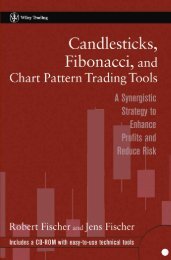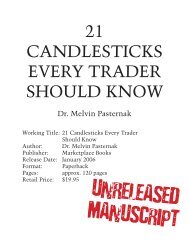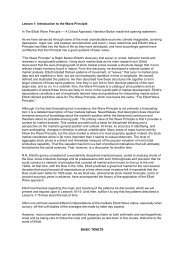The Ultimate Technical Analysis Handbook - Tradingportalen.com
The Ultimate Technical Analysis Handbook - Tradingportalen.com
The Ultimate Technical Analysis Handbook - Tradingportalen.com
Create successful ePaper yourself
Turn your PDF publications into a flip-book with our unique Google optimized e-Paper software.
Chapter 9 — Pick Your Poison... And Your Protective Stops<br />
Four Kinds of Protective Stops<br />
I have wanted to talk about protective stops for a long time in Trader’s Classroom, because they are one of the<br />
most difficult aspects of successful trade management. Why? Because if a protective stop is too tight, chances<br />
are you’ll get stopped out of a trade right before the big money move you were looking for. Conversely, if<br />
a protective stop is set too far away from where prices are currently trading, it opens you up to unnecessary<br />
market risk.<br />
Now before I offer my 2 cents on the subject, what exactly are protective stops? Protective stops are part of a<br />
strategy that aims to limit potential losses by setting a sell stop if you are long or a buy stop if you are short.<br />
Some traders strongly advocate using them, primarily because protective stops saved their trading accounts<br />
on more than one occasion. Other traders don’t use them at all, because they believe that having a protective<br />
stop in place simply gives floor traders (locals) in the pits something to gun for, a practice referred to as “stop<br />
running.”<br />
What exactly is stop running? It happens when floor traders who think they know where most of the resting<br />
buy or sell stops are located in a given market try to take profits by attempting to push prices into those stops,<br />
setting them off, and then letting the corresponding price move run its original course. Some say stop running<br />
is a myth, but on more than one occasion, I had my own positions stopped out by two or three ticks only to<br />
see prices return to moving in the direction I expected them to. Now, over the years of analyzing and trading,<br />
I’ve examined a number of different protective-stop techniques. Of the four I describe here, you will probably<br />
recognize two. <strong>The</strong> other two are personal favorites that I have developed.<br />
1. Parabolic<br />
<strong>The</strong> Parabolic System, also called the Stop and Reverse (SAR) System, was created by Welles Wilder<br />
(Figure 78). <strong>The</strong> essence of the Parabolic System is that it incorporates not just price but also time. So<br />
once a trade is initiated, it allows<br />
time for the market to react to the<br />
change in trend and then adapts as<br />
the trend gets underway. Simply<br />
put, when a change in trend occurs,<br />
the protective stop is far away from<br />
the actual market price, but as the<br />
trend develops over time, the stop<br />
progressively tightens, thereby protecting<br />
accrued profits.<br />
My 2 cents: Overall, I like Parabolic as a<br />
protective-stop technique, and I applaud<br />
Mr. Wilder for his genius. However,<br />
personally, I like my protective stops<br />
just a little bit tighter than what Parabolic<br />
sometimes offers.<br />
Figure 78<br />
<strong>The</strong> <strong>Ultimate</strong> <strong>Technical</strong> <strong>Analysis</strong> <strong>Handbook</strong> — © 2009 Elliott Wave International<br />
This ebook includes handpicked lessons from more than 200 pages of EWI’s <strong>com</strong>prehensive<br />
Trader’s Classroom Collection of eBooks. Learn more here: http://www.elliottwave.<strong>com</strong>/wave/ClubTCC<br />
50





